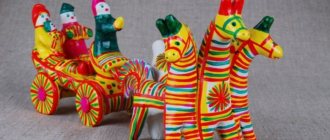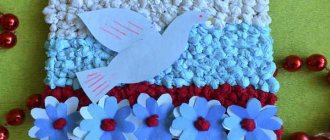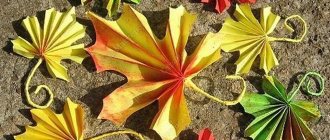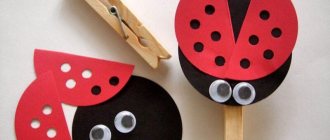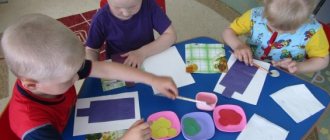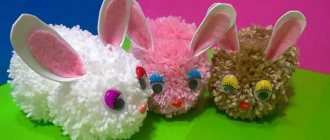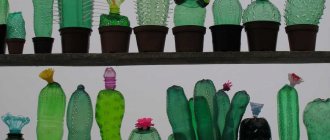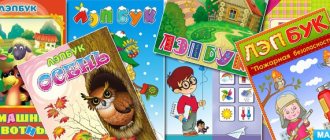The national folk toy is the heritage of our ancestors, passed on to us through the craft skills of the masters of the past. This is a unique combination of folk, arts and crafts and artistic creativity.
Toys usually differ in their type, what materials they are made from and how they are made. It can be considered very important that the toy is directly connected with the household and labor details of a person, with religious customs and rituals.
Figures of people, animals and objects are part of the educational process and social adaptation to the lives of children.
Corner "Folk Art" in the middle group
Natalya Kochurova
Corner "Folk Art" in the middle group
Corner " Folk Art " in the middle group
Decorative and applied arts are used in the pedagogical process in three directions:
-for interior decoration of preschool institutions, holidays, leisure activities;
-special training for children in painting folk ornaments ;
- for the development of children's creativity , both in the classroom and in the process of children's independent activities.
The purpose of creating a corner of folk arts and crafts is:
Formation and development of the foundations of a child’s artistic culture through folk decorative and applied arts;
• Involving children in artistic and creative activities ;
• Introducing to aesthetic culture;
• Formation of spiritual qualities and aesthetic taste in children;
• Development of artistic and creative abilities in children, the habit of bringing elements of beauty into life;
• Development of children's imagination;
• Development of fine motor skills in children;
• Enrichment of vocabulary in children.
Oral folk art in the education of preschool children To the question: “Who invented the miracle tree or Moidodyr?” any of you will answer that this is Korney Ivanovich Chukovsky. You can name it just as easily.
Oral folk art in the development of speech activity of young children The problem of developing the speech of preschool children through oral folk art is of particular importance today. Photo report on the festival of folk outdoor games within the framework of the project “Russian Folk Art” Good evening, dear colleagues! I would like to bring to your attention a selection of Russian folk outdoor games that we conducted as part of. Photo report on the work of the “Folk Art” circle Three years ago, when my children and I moved to the middle group, I started holding a “Folk Art” club with them. The main goal of the circle. Photo report on the thematic week “Russian Folk Art” I bring to your attention a photo report of the thematic week in the secondary group “Russian Folk Art”. This week, just like all the others.
Wooden toys
Toys sawn, planed or assembled from various elements are best made from hard wood:
- Apple tree,
- pear,
- oak,
- birch,
- pine (any conifer).
In addition to measuring tools and a pencil, you will need:
- hacksaw,
- plane,
- hammer,
- screwdrivers,
- glue gun
To connect the structural elements you will need:
- nails,
- screws,
- wood glue,
- silicone glue.
If crafts are made by cutting, then soft varieties of trees will be required. Basswood is a great wood to cut. For this work you will need wood carving tools:
- knife,
- straight and semicircular chisels,
- gravers (narrow semicircular chisel).
Where to arrange an exhibition corner and what needs to be taken into account?
Traditionally, the design of a corner in a kindergarten can consist of several components: the design of an exhibition of children's drawings in the locker room and a corner with materials and visual aids in the group room. However, experts consider it optimal to organize an art studio in a separate room, or to use temporarily free ones - a locker room, a hall, a corridor, and so on.
Our creativity
The developmental environment for visual arts is located in any place convenient for children. It is important that children feel like owners of toys and have free access to art materials and visuals. A prerequisite is a high level of design and aesthetics, as well as flexible use of preschool and preschool space. An exhibition of children's works is most often arranged in the locker room or near the exit from the group room in order to introduce parents to the creativity of their children. It is designed in the form of a stand, most often with tracks made of fishing line, on which drawings are hung using paper clips.
Clay toy
To work with this material, you need to understand what kind of clay there is, and there are two types: mountain and polymer.
Mountain or natural clay has several colors depending on the presence of iron, minerals and salts:
- Red. Holds temperature perfectly. In nature it is brown in color with a greenish tint.
- Blue. It contains many minerals and salts. A very good cosmetic product.
- White. The most affordable of natural clays. In nature it has a dirty dark gray color. It turns white after firing.
The artificial material for modeling is polymer. It has very important properties: heat resistance and ductility.
This type of technologically new material may require firing after modeling and may have the ability to harden on its own.
To work with this interesting product you may need the following accessories:
- Stable and level table.
- A cloth for wiping hands.
- Gloves if you suddenly have to mix the clay yourself.
- Apron.
- Small knife: stationery or pocket knife.
- Molds for applying patterns. They can not only be factory-made, but also be made from improvised materials.
- “Sandpaper” from zero to five.
- Rolling pin for rolling out clay. Any housewife can find it.
- Decorating products.
Recommendations for decorating a fine arts corner in the junior group of kindergarten
Kolmakova Marina Grigorievna
Educator
MBDOU No. 101, Tula
Recommendations for decorating a fine arts corner in the junior group of kindergarten
Creating a fine arts corner in a kindergarten group creates a favorable environment for children’s creative activity and promotes the emergence and development of independent artistic activity in preschool children.
The modern design of a fine arts corner in a kindergarten may consist of an exhibition of children's drawings in the locker room and a corner with materials, visual aids, colorful drawings and thematic attributes directly in the group.
The most important thing is that the art activity corner, the developmental environment in the kindergarten, should be located in a clear, optimal, convenient, accessible place for children. It is important that children feel like owners of toys and have free access to artistic and creative materials.
A prerequisite is a high level of design and aesthetics, as well as flexible and expanded use of the organized space of the corner. In order to introduce parents to the creativity of their children, exhibitions of children's works should be arranged in the locker room or in close proximity to the exit from the group room. Design options can be very diverse. For example, you can offer an option where crafts are displayed on a stand, perhaps with paths made of fishing line, on which drawings are hung using paper clips and other improvised materials.
Art corners in kindergarten help create optimal conditions in the group for the development of visual activity, independence and creative activity of children. Children get the opportunity to express themselves in various types of artistic and design activities, get acquainted with the world around them, learn the properties of objects, colors, correlate the concepts “object-color”, etc.
It is recommended that in the corner there should be a table with a lid or an easel, all kinds of paints, brushes, paper of different formats and textures, sponges, rags for hands and hands, paint palettes, jars for water, aprons, materials for modeling, in general everything, which will contribute to the artistic development of the child. If possible, it is better to place materials in a closet or special bedside table.
For clarity, reproductions, paintings, portraits of artists, arts and crafts, and folk art (haze, Gzhel, Khokhloma) should also be placed in the corner for clarity. There it is also necessary to place various didactic games to introduce children to various directions and genres - still life, portrait, landscape; with painting, graphics, decorative and applied arts, architecture; with flowers and their shades. In the corner of artistic manual labor, it is important to place samples of fabrics, seams, and other materials for children to learn about their surroundings.
Another great suggestion is if there is a place in a corner or nearby where children can optionally watch filmstrips, videos, listen to music, or see how different types of art are connected.
The teacher needs to introduce children to the corner of fine arts:
1. Tell about its structure and direct purpose,
2. Teach children to look at pictures, creative materials and other attributes only there;
3. Tell the children the rules to follow regarding the iso-corner:
- take albums, reproductions, portraits only with clean hands;
- leaf through carefully;
- do not tear, crush, or use for games;
- after looking, always put the book or picture back in its place.
Before you start decorating, think about what you will place and where, what components you cannot do without. Achieve aesthetics and relevance in design. So, the main and important conditions for the design of iso-corners for all kindergarten groups are:
1. Optimal location of the visual arts area: accessibility, aesthetics, mobility, safety;
2. Using notes of a “child’s hand” in design;
3. Availability of works of art, compliance with age requirements;
4. Availability of visual material: variety, age requirements, accessibility;
5. Availability of equipment for drawing, modeling, appliqué;
6. Don’t neglect working with color and lines;
7. Use of various techniques of visual creativity, compositions;
8. Presence of folk arts and crafts;
9. Demonstration of various genres of painting, clay samples; artistic handicrafts;
10 Organization of work with children outside the area of artistic and aesthetic development - long-term plans.
The design of the corner may be different for each teacher. The main thing is an individual approach, clarity, and compliance with age norms. The rest depends on the creativity and imagination of the preschool teacher.
Good luck!
Matryoshka
This Russian doll is no less popular than Barbie. And doing it yourself will not be difficult.
From cardboard
To make a matryoshka doll from cardboard you will need:
- Red cardboard.
- Set of multi-colored paper.
- Markers.
- Scissors.
- PVA glue or glue stick.
- A simple pencil.
Making the preparation:
- Draw a blank on the wrong side of the cardboard and cut it out.
- We make a scarf from yellow paper (or any other color you like). To do this, place the blank on a colored sheet and trace only the upper part.
- Cut out the scarf and paste it onto the top of the matryoshka doll.
- We cut out a circle from white paper and heat this circle onto the top of the future matryoshka doll. Next we draw the face.
Decorate the nesting doll with a flower:
- Cut out a square from colored paper.
- Fold it diagonally several times.
- Using scissors, round off the ends.
- We unfold the flower and heat it onto the matryoshka doll.
Beaded birch
To make this craft you will need:
- Green beads.
- Wire thickness from 0.3 mm to 1 mm.
- Threads.
- Alabaster.
- PVA glue.
- Acrylic paint and brush.
Getting the job done.
- We put beads on the wire and twist them into a loop. You need 15 such blanks.
- We connect the branches together.
- We form the trunk.
- We take any container.
- We dilute alabaster with glue and water in the following proportion: 2 tbsp. spoons of alabaster, 1 tbsp. spoon of glue, dilute with water, leave everything for 12 hours.
- We paint the branches of the trunk with this solution.
- Apply black paint to the dry white paint.
Folk themed rag dolls
To bring such a doll into the world we will need:
- Fabric size: forty by fifteen centimeters (white, variegated and plain).
- A small “rag” for an apron, ten by eight centimeters.
- We will use the yarn to make hair.
Stages of making a doll:
- We make the body. Place padding polyester on a piece of white fabric and fold the fabric in half.
- Head. We make a twist at the end and secure it with thread.
- Hands. Fold the fabric in half and tie the edges.
- We fasten the body and arms with thread. Using thread we make a cross-shaped pattern on the chest. This will connect the arms and body. We wrap her belt. We tighten the thread.
- Create an underskirt. Folds form on plain fabric. We fasten the skirt with threads. We put a skirt on the doll
- Attach an apron and belt. We tie the fabric for the apron with a thread to the front (front) part of the doll.
- Making hair. We wind the yarn onto thick cardboard in several layers, then cut the yarn from one edge. Align the bun and secure it to the head.
The above examples are not all that is in the tradition of making “Russian folk toys”. With this article I wanted to attract as many people as possible to the study of native traditions, rituals and the history of Russia in general.
Folk art corner in the group.
Svetlana Isaeva
Folk art corner in the group.
Young children should be approached with the simplest and most accessible to them. household items (made using the papier mache technique) in our corner of folk art.
, painted under Khokhloma and Gzhel.
Folk toys are of great importance in a child’s life . Bright, unusual toys activate a child’s independent activity; they also play a big role in aesthetic education, create a positive emotional microclimate, and form a positive attitude towards the environment. Together with the children, we made toys from plasticine.
Having rolled them in flour, the children painted them based on Russian folk art - Dymkovo , Gorodets and Bogorodsk painting.
In addition to these crafts, Kuvadka dolls are presented corner
Museum of Folk Art The goals of creating the museum are to introduce children to folk crafts, deepen and expand knowledge about the culture of the Russian people, and cultivate respect. Patriotic education through oral folk art To be a patriot means to feel like an integral part of the Fatherland. This complex feeling arises even in preschool childhood, when it is formed.
Project in the junior mixed-age group “Development of children’s speech through oral folk art” Project in the junior mixed-age group: “Development of children’s speech through oral folk art.” Prepared and conducted by: Mishchenko.
The role of oral folk art in raising children Oral folk art in scientific literature is called Russian folklore, Russian oral folklore. They exist in folk art.
